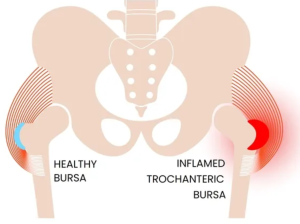Hip bursitis is a common yet painful condition that affects many individuals. This condition often leads to discomfort, limited mobility, and decreased quality of life. Fortunately,
physiotherapy can be an effective approach to alleviate pain, improve mobility, and enhance strength. In this blog, we will explore what hip bursitis is, its symptoms, and how physiotherapy can help in managing and treating this condition.
Understanding Hip Bursitis
Hip bursitis is the inflammation of one or more bursae in the hip joint.
Bursae are small, fluid-filled sacs that cushion and reduce friction between bones, tendons, and muscles around joints. In the hip, two bursae commonly become inflamed: the trochanteric bursa on the outside of the hip and the iliopsoas bursa on the inside.

Diagram showing greater trochanteric bursitis
Causes of Hip Bursitis
- Repetitive Overuse: Firstly, continuous activities that involve repetitive hip movements, such as running, cycling, or climbing stairs, can lead to bursitis.
- Trauma or Injury: Additionally, a fall or direct impact on the hip can cause inflammation of the bursae.
- Muscle Imbalances: Similarly, weak or tight hip muscles can disrupt the biomechanics of the hip joint, increasing the risk of bursitis.
- Certain Medical Conditions: Unfortunately, conditions like rheumatoid arthritis or gout can contribute to bursitis.
- Bone Spurs: Also, abnormal bone growth around the hip joint can irritate the bursae and trigger inflammation.
Symptoms of Hip Bursitis
The symptoms can be quite distressing and may include:
- Pain on the outside of the hip, which can radiate down the thigh.
- Pain that worsens with activities such as walking, climbing stairs, or standing for prolonged periods.
- Swelling and tenderness over the affected bursa.
- Reduced range of motion and stiffness in the hip joint.
- Discomfort while lying on the affected hip.
How Physiotherapy Can Help:
Physiotherapy plays a crucial role in managing and treating hip bursitis. Here are some ways in which it can help:
- Pain Relief: Physiotherapists use hands-on techniques to reduce pain and inflammation in the hip joint. Additionally, they use modalities like heat, ice, laser therapy to alleviate pain and promote healing.
- Exercise Prescription: Specific stretches can improve hip flexibility and reduce muscle tightness. Similarly, targeted exercises enhance the strength of the hip muscles, helping to stabilize the joint. Finally, exercises that improve balance can reduce the risk of falls and further injury.
- Gait Training: Physiotherapists can analyze your walking pattern and provide guidance to reduce stress on the affected hip.
- Education and Lifestyle Modification: Educating patients about proper body mechanics and ergonomics can prevent further aggravation of the condition. Also, recommendations for activity modification may be provided to reduce strain on the hip.
- Assistive Devices: Depending on your condition, a physiotherapist might recommend assistive devices such as crutches or braces to aid mobility.
What can I do about my hip pain?
Hip bursitis can be a painful and debilitating condition, but with the right approach, you can manage and alleviate its symptoms. Physiotherapy offers a holistic solution by addressing pain, mobility issues, and muscle imbalances. If you suspect you have this condition or are experiencing hip pain,
consult a physiotherapist for a personalized treatment plan to help you regain your mobility and improve your quality of life. Remember, early intervention and a dedicated physiotherapy program can make a significant difference in your recovery journey.





Leave a Reply